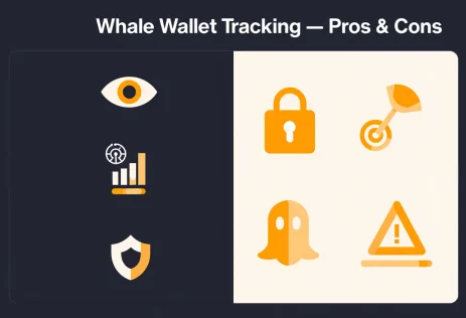Physical Address
304 North Cardinal St.
Dorchester Center, MA 02124
Physical Address
304 North Cardinal St.
Dorchester Center, MA 02124

In the ever-evolving world of cryptocurrency, a crypto whale wallet tracker is becoming one of the most essential tools for savvy traders and investors. A crypto whale refers to a person, organization, or entity that holds a large amount of digital currency, substantial enough that their trades can move entire markets. A wallet tracker is a tool or service designed to monitor and analyze the activity of these whales in real time across public blockchains.
Why does this matter for you? Because following the money means gaining critical market insights, catching early trends, and adding an extra layer of transparency to an often-volatile space. For instance, in April 2024, a single Bitcoin whale caused a $20 million price swing, making headlines and impacting thousands of traders. This ultimate guide for 2025 breaks down what crypto whales are, how wallet trackers work, the best tools to use, and tactical steps to leverage whale data for better trading and investing decisions.
A crypto whale is simply someone or something that holds a significant amount of cryptocurrency, often enough to influence the price of that asset by their buying or selling activity. The term whale has its roots in traditional finance, where big investors or market makers were seen as large fish who could sway markets. In crypto, this role has grown even more pronounced due to the relative youth and liquidity constraints of digital assets.

Whales are significant because their market moves, whether transferring $100 million in Bitcoin or unstaking huge amounts of ETH, can spark rapid price swings, impact liquidity, and shift trader sentiment almost instantly. Analysts, institutions, and even central exchanges often monitor whale wallets because these outsized players often indicate underlying trends or potential market volatility.
Who qualifies as a whale? Here are the common profiles:
Notable examples include MicroStrategy’s ongoing Bitcoin accumulation and the Ethereum Foundation’s transparent on-chain transactions. Understanding these players sets the stage for why whale wallet tracking is so critical in crypto trends 2025 and beyond.
To explore similar concepts, check our crypto knowledge section for beginner-friendly explanations.
A crypto whale wallet tracker is a tool or software that monitors the blockchain for significant wallet activity, specifically targeting addresses known or believed to belong to whales. These platforms tap into the transparent, public nature of blockchains, where every transfer, withdrawal, or massive swap is immutably recorded and accessible in real time.

Crypto wallet trackers work by listening to the blockchain, flagging high-value transactions, and labeling addresses based on past behavior or public announcements. Users can track activity manually (using public explorers like Etherscan) or leverage automated platforms that aggregate, analyze, and deliver alerts. Here’s a quick comparison:
| Manual Tracking | Automated Tracking |
|---|---|
| Use block explorers | Use platforms like Whale Alert, Nansen, or BonkBot |
| Requires searching for wallet addresses by hand | Addresses and activities are labeled and followed automatically |
| No real-time alerts; must refresh or monitor constantly | Instant notifications via Telegram, webhooks, or email |
| Free, but time-intensive; prone to missing larger patterns | Free & paid options; advanced analytics and filtering |
This layered visibility bridges to the next section: Why tracking whales can make a difference in your investing or trading journey.
Consider this: In 2024, closely monitoring an Ethereum whale address revealed a major sell-off, and ETH dropped 5% within hours, catching unprepared traders off guard.
Who benefits from whale tracking?
Whether you’re in it for short-term swings or building a macro portfolio, whale tracking provides tactical intelligence, if you use the right tools and interpret signals with care.
At their core, whale trackers continuously scan public blockchains (like Bitcoin, Ethereum, Solana) to identify wallet addresses involved in large-value transactions. Here’s how the process breaks down:
Imagine this flow: A whale transfers 1,000 BTC from cold storage to Binance. The tracker identifies the address as a known whale, triggers an alert, and the platform pushes a notification. Power users read context, combine with other data, and make strategic decisions.

This real-time, always-on monitoring is what sets whale wallet trackers apart, and knowing exactly what features to look for makes all the difference.
View more:
Real-Time Alerts and Notifications
Immediate push alerts (via email, SMS, Telegram, or webhooks) let users react instantly when whales move, vital for both day traders and long-term investors. For example, Whale Alert displays a live pop-up when $10M+ Bitcoin is transferred.
Address Labeling and Identity Features
Top platforms identify wallet owners (if possible), label them as exchanges, funds, or DeFi whales, and save users from guesswork. This enhances trust in the alert’s meaning.
Multi-Chain and Asset Coverage
Crypto isn’t Bitcoin-only. Look for trackers that monitor major networks (Ethereum layer 2s, Solana, BNB Chain) and assets, so you don’t miss key cross-chain movements.
Analytics & Visualization Capabilities
Dashboards featuring charts, trendlines, transaction histories, and heatmaps help users interpret whale activity at a glance. Platforms like Nansen excel at these visual tools.
Custom Filters, Alerts & User Settings
Advanced users can filter by token, transaction size, wallet type, or specific protocols. Imagine getting notified only for ERC-20 whale swaps over $5M, or only for NFT sweeps on Solana.
When evaluating tools, the best whale wallet tracker for 2025 will fit your workflow and deliver speed, context, and flexibility, without overwhelming you with noise. Next, let’s break down the top options.
| Tool | Blockchains | Alerts | Unique Features | Pricing |
|---|---|---|---|---|
| Whale Alert | BTC, ETH, and more | Transfers | API, Twitter/Telegram alerts | Free & Paid |
| Nansen | Multi | Activity | Smart Money, wallet labels | Paid |
| BonkBot | Solana | NFT Sweeps | Automated trading, sweep detection | Free & Paid |
| CryptocurrencyAlerting | Many | Custom | Webhook triggers, tailored alerts | Free & Paid |
| Coinglass | BTC, ETH | Liquidations | Exchange analytics, funding rates | Free & Paid |
Whale Alert is ideal for quick, free Bitcoin and Ethereum alerts via Twitter, perfect for staying on top of urgent transfers. Nansen offers deep wallet labeling, Smart Money dashboards, and research-grade analytics for professionals, though it is paid. BonkBot stands out for Solana NFT sweeps and integrates trading automation, making it a favorite for NFT-centric users. CryptocurrencyAlerting supports a vast array of coins and custom notifications, while Coinglass focuses on derivatives, price movements, and liquidation data, a favorite among institutional or futures traders.
Choose the tracker that best matches your assets, goals, and preferred alert methods to gain a competitive edge.
This process, layered with curiosity and caution, helps you distinguish actionable whale activity from background noise.
Tracking whale wallets offers unique market visibility, think of it as an early warning radar. By monitoring these outsized players, you may catch trend reversals, sudden liquidity spikes, or brewing FOMO before mainstream news catches up. However, it’s crucial to understand what whale data can, and can’t, reveal.
Benefits: Improved market intelligence, timely signals, better awareness of market sentiment, and a valuable tool for building or protecting a portfolio.

Limitations & Risks:
Ethically, all tracking uses public, permissionless data, still, avoid doxxing individuals or relying exclusively on wallet tracking for significant market decisions. Sometimes, following whale moves can even create herd behavior and unintended volatility, as seen in cases where sudden large transactions led to overreactions and price whipsaws.
Pro traders in 2025 blend tracker tools and analytics platforms to gain a 360-degree market view without falling for every spike or dip.
Are crypto whale trackers accurate?
Most reputable trackers provide highly accurate data since they pull from public blockchains. However, accuracy can vary if a whale uses multiple unknown wallets or privacy measures.
Is tracking whale wallets legal?
Yes, blockchain data is public and open by design. Tracking is ethical as long as it doesn’t aim to dox private individuals or misuse off-chain information.
Can ANY wallet be tracked on all blockchains?
Most major public blockchains (like Bitcoin and Ethereum) are fully transparent, but privacy chains (such as Monero) restrict visibility. Some cross-chain movements are harder to trace end-to-end.
How do whales hide, or avoid detection?
Advanced users split funds across multiple wallets, use mixers, or shift assets via privacy protocols to avoid large, traceable transactions. This limits tracker visibility, but most large moves on big chains remain detectable.
| Term | Definition |
|---|---|
| Whale | An individual or entity controlling large amounts of cryptocurrency |
| Wallet | A digital address or storage solution for holding crypto assets |
| On-chain | Activity or data recorded directly on a public blockchain |
| ERC-20 | A popular Ethereum token standard for fungible tokens |
| NFT Sweep | A large bundle purchase of NFTs, often in one transaction |
| Block Explorer | Website/tool to view all blockchain transactions by wallet or block |
| Smart Money | Funds or wallets identified as sophisticated/profitable |
| API | Application Programming Interface for accessing live blockchain data |
| Liquidity | The ease with which assets can be bought or sold in markets |
| Mixers | Tumblers that obfuscate transaction trails for privacy |
| Cold Storage | Offline storage method, typically more secure from hacks |
| OTC (Over-the-Counter) | Direct trades between parties, bypassing public exchanges |
Related Articles: What Does Degen Mean in Crypto?
Crypto whale wallet trackers have become essential for anyone serious about navigating digital asset markets in 2025. By understanding whales, leveraging transparent on-chain data, and choosing the right tools, both newcomers and seasoned pros can anticipate price swings, spot opportunities, and reduce surprises. Remember, while whale tracking is powerful, combine it with broader research, refined strategies, and critical thinking to maximize your market edge. As crypto continues to evolve, staying informed and adaptable is your best asset.
Web Tai Chinh delivers fast, accurate updates and comprehensive insights on finance and investments, offering users the knowledge they need to make informed decisions and gain clarity on complex financial concepts and terminology.
📞 Contact: 055 937 9204
✉️ Email: webtaichinh@gmail.com
📍 Address: 13 Ho Tung Mau, An Binh, Di An, Binh Duong